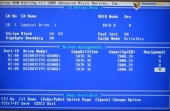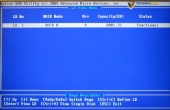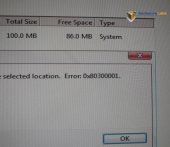Specifications:
Found on Adaptec’s website here
Key RAID Features:
• Supports up to 4 (6405E) or 8 (6805E) SATA or SAS devices
• SES and SAF-TE enclosure management
• RAID levels 0, 1, 10, 1E, and JBOD
• Hybrid RAID 1 & 10
• Quick initialization
• Online Capacity Expansion
• Copyback Hot Spare
• Dynamic caching algorithm
• Native Command Queuing (NCQ)
• Background initialization
• Hot-plug drive support
• RAID Level Migration
• Hot spares – global, dedicated, and pooled
• Automatic/manual rebuild of hot spares
• Configurable stripe size
• S.M.A.R.T. support
• Multiple arrays per disk drive
• Dynamic sector repair
• Staggered drive spin-up
• Bootable array support
• Optimized Disk Utilization
What is the best RAID configuration? Well, that depends on what you are looking for, speed or reliability, maybe a little of both. The results of your choice will also depend on how deep your pockets in terms of your means to purchase the required hardware beyond the RAID card. The fastest configuration being a stripe set where data is striped across multiple drives which is the most risky. The loss of just one drive in a stripe results in loss of all data on the RAID set of drives. RAID 1 is a mirror of one drive to another which gives you the read/write access times that match a single drive, but in the event you lose one drive, the PC OS will continue to run without the OS even knowing there is a failure. Finally RAID 5 which requires at least three drives and gives you the protection of losing one of the drives and gives you better access times than a single drive or a mirror, but still not quite as fast as a stripe.
We selected the ASUS Crosshair IV Formula motherboard as the test bed for this review since it has on-board RAID as a feature. We put it into play and ran benchmarks to provide you an idea of what to expect with on on-board RAID system in comparison to an after market RAID card. The configuration of the BIOS of our Crosshair IV formula board took a bit to understand but ultimately we were able to configure four of the Western Digital drives in a RAID 0, running the OS from a solid state in order to show scores of access times without having to compete with an OS loaded on the same volume.
 |
 |
| ASUS Formula IV on-board RAID setup Screen | ASUS Formula IV on-board RAID volume assigned |
While testing the different RAID setups we had initially loaded an OS on each RAID container, but this was taking too long and essentially would give a score that wasn’t the highest it could be. We eventually loaded our OS via a solid state drive and then loaded the RAID containers as additional storage. One of the errors we ran into while loading Windows7 was a ” Error: 0x80300001 ” message. This was quickly remedied by a internet search. The issue was the Windows7 DVD was used to install Windows7 up to the point of requesting the storage controller driver. We swapped out the DVD for the manufacturers DVD to load the driver after which this message appeared. The resolution to this message was to swap out the Driver DVD with the Windows7 DVD of which there was no on-screen explanation of what error 0x80300001 was. Internet to the rescue!
 |
 |
Test System:
Windows7 64bit Home Edition
ASUS Crosshair IV Formula motherboard
AMD Phenom II X6 1090T
Tuniq Ensemble 1200 Watt PSU
LIAN LI PC-A77F
Crucial Ballistix 16GB (4 x 4GB) 240-Pin DDR3 SDRAM DDR3 2000 (PC3 16000) Desktop Memory

We are using the 6805E controller in a VMWare development setup and it is a reasonably good controller. It would benefit from a bigger cache and the ability to use an SSD for further caching. These are features of other controllers with a considerably bigger price tag though. As it is, the controller does very well on not too random work loads but on purely random IO (like some SQL tasks), it only delivers about 13 mb/s on an otherwise lightly loaded RAID 10 setup. That is not too good. If you are not using VMWare but maybe some Linux setup, you can add your own SSD caching via flashcache (https://github.com/facebook/flashcache/). With a setup like that, you get both redundancy and great performance. On the whole, the controller is certainly preferable to on board SW RAID solutions and such but it could be a lot better too.